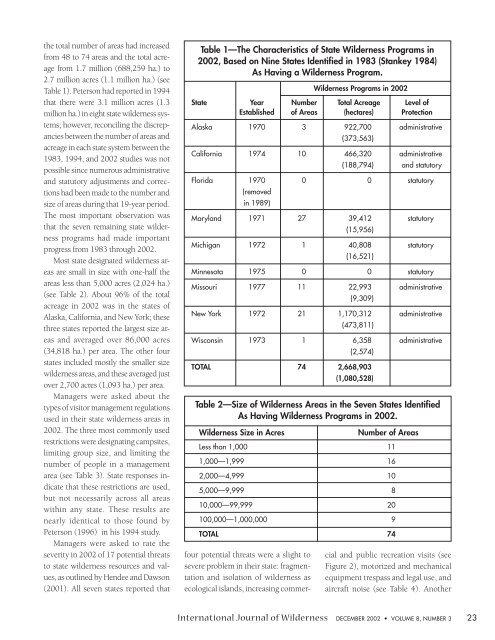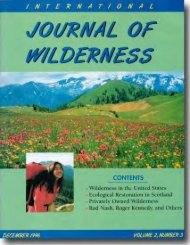Download full PDF - International Journal of Wilderness
Download full PDF - International Journal of Wilderness
Download full PDF - International Journal of Wilderness
You also want an ePaper? Increase the reach of your titles
YUMPU automatically turns print PDFs into web optimized ePapers that Google loves.
the total number <strong>of</strong> areas had increased<br />
from 48 to 74 areas and the total acreage<br />
from 1.7 million (688,259 ha.) to<br />
2.7 million acres (1.1 million ha.) (see<br />
Table 1). Peterson had reported in 1994<br />
that there were 3.1 million acres (1.3<br />
million ha.) in eight state wilderness systems;<br />
however, reconciling the discrepancies<br />
between the number <strong>of</strong> areas and<br />
acreage in each state system between the<br />
1983, 1994, and 2002 studies was not<br />
possible since numerous administrative<br />
and statutory adjustments and corrections<br />
had been made to the number and<br />
size <strong>of</strong> areas during that 19-year period.<br />
The most important observation was<br />
that the seven remaining state wilderness<br />
programs had made important<br />
progress from 1983 through 2002.<br />
Most state designated wilderness areas<br />
are small in size with one-half the<br />
areas less than 5,000 acres (2,024 ha.)<br />
(see Table 2). About 96% <strong>of</strong> the total<br />
acreage in 2002 was in the states <strong>of</strong><br />
Alaska, California, and New York; these<br />
three states reported the largest size areas<br />
and averaged over 86,000 acres<br />
(34,818 ha.) per area. The other four<br />
states included mostly the smaller size<br />
wilderness areas, and these averaged just<br />
over 2,700 acres (1,093 ha.) per area.<br />
Managers were asked about the<br />
types <strong>of</strong> visitor management regulations<br />
used in their state wilderness areas in<br />
2002. The three most commonly used<br />
restrictions were designating campsites,<br />
limiting group size, and limiting the<br />
number <strong>of</strong> people in a management<br />
area (see Table 3). State responses indicate<br />
that these restrictions are used,<br />
but not necessarily across all areas<br />
within any state. These results are<br />
nearly identical to those found by<br />
Peterson (1996) in his 1994 study.<br />
Managers were asked to rate the<br />
severity in 2002 <strong>of</strong> 17 potential threats<br />
to state wilderness resources and values,<br />
as outlined by Hendee and Dawson<br />
(2001). All seven states reported that<br />
Table 1—The Characteristics <strong>of</strong> State <strong>Wilderness</strong> Programs in<br />
2002, Based on Nine States Identified in 1983 (Stankey 1984)<br />
As Having a <strong>Wilderness</strong> Program.<br />
four potential threats were a slight to<br />
severe problem in their state: fragmentation<br />
and isolation <strong>of</strong> wilderness as<br />
ecological islands, increasing commer-<br />
<strong>Wilderness</strong> Programs in 2002<br />
State Year Number Total Acreage Level <strong>of</strong><br />
Established <strong>of</strong> Areas (hectares) Protection<br />
Alaska 1970 3 922,700<br />
(373,563)<br />
administrative<br />
California 1974 10 466,320 administrative<br />
(188,794) and statutory<br />
Florida 1970<br />
(removed<br />
in 1989)<br />
0 0 statutory<br />
Maryland 1971 27 39,412<br />
(15,956)<br />
statutory<br />
Michigan 1972 1 40,808<br />
(16,521)<br />
statutory<br />
Minnesota 1975 0 0 statutory<br />
Missouri 1977 11 22,993<br />
(9,309)<br />
administrative<br />
New York 1972 21 1,170,312<br />
(473,811)<br />
administrative<br />
Wisconsin 1973 1 6,358<br />
(2,574)<br />
administrative<br />
TOTAL 74 2,668,903<br />
(1,080,528)<br />
Table 2—Size <strong>of</strong> <strong>Wilderness</strong> Areas in the Seven States Identified<br />
As Having <strong>Wilderness</strong> Programs in 2002.<br />
<strong>Wilderness</strong> Size in Acres Number <strong>of</strong> Areas<br />
Less than 1,000 11<br />
1,000—1,999 16<br />
2,000—4,999 10<br />
5,000—9,999 8<br />
10,000—99,999 20<br />
100,000—1,000,000 9<br />
TOTAL 74<br />
cial and public recreation visits (see<br />
Figure 2), motorized and mechanical<br />
equipment trespass and legal use, and<br />
aircraft noise (see Table 4). Another<br />
<strong>International</strong> <strong>Journal</strong> <strong>of</strong> <strong>Wilderness</strong> DECEMBER 2002 • VOLUME 8, NUMBER 3 23










